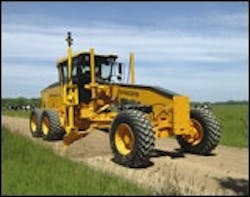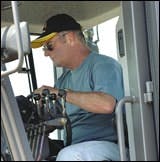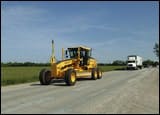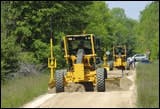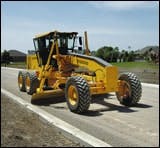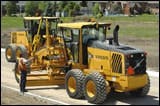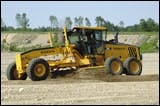Eleven Chances to Hit the Right Gear on Volvo's G900-Series Motor Graders
Volvo makes the case that more transmission speeds allow operators to better match engine rpm to the task at hand, resulting in reduced engine speeds and lower fuel consumption. Also, says the company, the Volvo engine's ability to produce high torque at relatively low speeds "encourages the use of a higher transmission gear, because drivability and lugging power are not sacrificed." To test these claims, Volvo delivered a G940 motor grader and two transmissions, an 8F/4R model HTE840 and an 11F/6R model HTE1160, to the University of Nebraska's Tractor Test Laboratory, which has provided vehicle-performance and fuel-consumption testing since 1920. The object was to evaluate the G940's fuel consumption under simulated operating conditions with the 8-speed transmission, then with 11-speed. Using the same machine and swapping transmissions, says Volvo, eliminated a host of other variables.
During the evaluations, the motor grader maintained a constant ground speed while towing a test vehicle that provided a constant load. Both the 8-speed and the 11-speed were used in two simulated work applications, and multiple runs with each transmission helped established consistency.
According to test-summary data that Volvo provided, the simulated applications involved ground speeds of 2.2 and 9.0 mph, and corresponding drawbar loads of 4,500 and 3,500 pounds. In each instance, the 11-speed-equipped machine used less fuel, by 5.7 and 6.4 percent, respectively.
Between the two of them, George McHattie and Gord Diamond have more than 70 years operating motor graders. We figured that kind of experience qualified them to help us with an experiment of sorts that Volvo and Construction Equipment devised for comparing the company's new 11-speed motor-grader transmission with its also-new (but more conventional) 8-speed counterpart. Both of these new powershift transmissions, specifically engineered by Volvo for its new G900-Series motor graders, are direct-drive countershaft types, but one uses 8F/4R gearing, while the other's configuration is 11F/6R. Do more gears yield advantages on the jobsite?
That's where McHattie and Diamond came in. We enlisted their help to answer that question from an operator's point of view. Our guest operators used two G940s, one with an 8-speed and the other with an 11-speed transmission, to grade gravel on a county road; trim road-base limestone in a housing development; hog out dirt in a ditching exercise; and to hightail it between jobsites in Goderich, Ontario's, morning traffic. (On the eastern shore of Lake Huron, Goderich is home for Volvo's motor-grader operations.)
Also assisting in this effort were Trimble Navigation's Mike Read, Kent Kahle and Rod Elliott, who equipped the G940 test units with a total-station grade-control system and a sonic-tracer system. The intent with these systems was to keep blade depth comparable between the two units when working in the same material, thus eliminating depth-of-cut as a factor in the operators' perceptions of machine performance. Representing Volvo Construction Equipment were Brian Lowe, product and communications manager, and Russell Sharpe, demonstration operator — and former contractor with 30-plus-years experience on motor graders.
The G940 units that McHattie and Diamond put to work in Goderich this past June are second in size in Volvo's new G900-Series lineup, which includes five tandem-drive models (G930, G940, G960, G970, G990) and two all-wheel-drive models (G946 and G976). These machines range in base operating weight from around 34,000 to 46,000 pounds, and in maximum net horsepower from 195 to 265. The new model range supersedes Volvo's B-Series models (introduced in 2002), which served the company well by helping extend its reach into the private-contractor and county/municipal market segments. But with the introduction of the completely redesigned G900-Series, Volvo seems to have attained its ultimate motor-grader goal, namely, developing a premium range of models with broad market appeal and with features that provide a measure of product distinction in a crowded marketplace.
And in a world where eight speeds are considered the norm, the G900-Series' new 11-speed transmission qualifies as one of those distinctive features.
You don't have to hang out with good motor-grader operators too long before you pick up on the fundamentals of using the machine. And among those basic principles is that of matching an appropriate transmission gear to an appropriate engine speed to keep the machine moving smoothly on the grade. The right balance means having enough torque to do the job (but not so much as to risk spinning the wheels and marring the grade), yet also having enough speed to work at a reasonable pace without the engine constantly bumping up against maximum speed.
To help operators more easily find and maintain this balance, says Volvo, the G900-Series combines new transmission technology with new engine- management technology. Efficiently managing the engine's power complements the capability of the new 8-speed transmission, says the company, but works exceedingly well with the 11-speed.
Whether the engine in a G900-Series machine is driving an 8-speed or an 11-speed, it is programmed to produce three power bands, which deliver a different net horsepower rating for specific gearing groups. For instance, the 8-speed G940, with the engine at 2,100 rpm, produces 175 horsepower (F1, F2, R1), 195 horsepower (F3, F4, F5, R2, R3) and 215 horsepower (F6, F7, F8, R4). The 11-speed G940 has identical horsepower ranges, but adds an extra forward gear in each of the three power bands, plus an extra reverse gear in the low and high bands.
According to Volvo, the system provides a fairly precise speed/torque match in applications that typically would fall within a gearing group. But it also provides operators the means to fine-tune these parameters. The panel-mounted Throttle-Control rocker switch, for instance, allows the operator to quickly raise or lower engine speed in set increments. The Throttle-Mode switch functions as an engine-speed cruise control, allowing a selected rpm setting to be maintained without the foot throttle — and also allowing the setting to be cancelled (or not cancelled, if the operator so chooses) via the inching pedal.
The smartest switch in the cab, however, is that for Engine Mode. Using this control, the operator can toggle at will between a Power and a Speed setting to actually change the engine's torque curve when it's running in either of its two lower horsepower bands.
In Power setting, intended for grading operations, engine speed is capped at a maximum 1,900 rpm and, according to Volvo, torque gets a boost, fuel consumption diminishes, and sound levels drop significantly. In the Speed setting, the engine changes its torque curve for more efficient operation at higher ground speeds.
Buyers have three transmission choices for G900-Series models, and the logic behind the choices, says Volvo, is having the ability to closely match features to customer requirements. As noted, all transmission choices are direct-drive, countershaft, powershift models, and all use pulse-width modulation (PWM) of their hydraulic clutches. PWM is essentially electronic regulation of the clutch's engagement and disengagement interval, with the aim of smoothing the transition from one gear to another.
The standard transmission is the Manual-Mode 8-speed (model HTE840). This choice allows shuttle shifting (on-the-move directional changes without using the inching pedal), remembers the operator's preferred gear coming out of a directional change, downshifts automatically and affords over-speed protection.
An optional 8-speed adds two features to the standard transmission: Auto-Mode, which, essentially, automatically shifts up or down between a base gear and a selected upper gear; and Travel-Mode, which shifts the transmission (automatically) more rapidly for faster acceleration to top speed when traveling between jobsites.
The third choice, the 11-speed model HTE1160, is optional for all G900-Series motor graders and combines all manual-mode, Auto-Mode and Travel-Mode features with the addition of three extra forward gears and two added reverse gears. If you compare ground speeds for matching gears in a G940's 8-speed and 11-speed transmissions (with the engine running at 2,100 rpm), you'll find the 11-speed a bit slower. In 1st gear, for example, speeds are 2.7 versus 2.1 mph, respectively. Eighth-gear speeds are 28.4 versus 14 mph, respectively. But the 11-speed continues to notch up to 18.2, 23.8 and 30.8 mph in its three remaining gears.
Correspondingly, when the engine is running at peak-torque rpm in a particular gear, the 11-speed transmission again yields lower ground speeds. In gears one through five, for instance, ground speed varies from 1.4 to 5.9 mph for the 8-speed, and 1.1 to 3.5 mph for the 11-speed. If the machine is being operated in the Engine-Mode's Power setting, then ground speed will be reduced approximately 10 percent from the rated-speed number.
The net results of the 11-speed transmission's performance characteristics are that it provides a lower first gear, a higher top gear, and smaller steps in ratio between gears along the way. This latter characteristic, according to Volvo, accounts for much of what the company considers the refined performance of the 11-speed.
So, how does all this translate to the jobsite?
The first comparison of the two G940s was a 6.9-mile trek from the Volvo factory to a stretch of gravel road that had been temporarily closed for our purposes. Both transmissions were used in their fast-shifting Travel Mode, and Volvo's Sharpe made sure that tires were all equally inflated and that fuel levels were the same.
We started the watch on each machine as it pulled onto the paved secondary road that led to the jobsite, and stopped timing when the machines, still at full speed, passed a designated spot just before the jobsite turnoff. We found the 11-speed G940 just slightly more than 9 percent faster than its 8-speed counterpart.
For the two grading exercises (the county road and the housing development), the operators generally ran the machines at between 1,200 and 1,400 rpm. When grading on the gravel road, the machines made multiple 1,000-foot pushes at depths that averaged probably 1.25 inches. On these pushes, the Engine-Mode switch in both machines was in its Power setting.
After each operator had run both machines, they told us that they had run the 8-speed in 3rd gear and the 11-speed in 5th gear. Assuming that the rpm setting at which the units were operated placed the engines near their peak-torque rating, then we can estimate that ground speed was approximately 3.5 mph for the 8-speed and 4.1 mph for the 11-speed. To give just a bit more context here, the 8-speed's 4th gear, peak-torque ground speed would have been 4.9 mph, apparently too fast for this situation in the opinion of both operators.
The approximate half-mile-per-hour production advantage for the 11-speed (4.1 versus 3.5) may be less noteworthy, however, than what both operators considered the 11-speed's superior performance characteristics. Diamond summed up the consensus of opinion:
"After running both machines, it was apparent that the 11-speed shifted more smoothly. By comparison, the 8-speed had a tendency to lurch a bit between gears, and I used the inching pedal to try to smooth out the shifts. But I didn't use the inching pedal with the 11-speed. You get some wheel bounce between shifts with the 8-speed, and this will create a washboard if you don't work to prevent it."
According to McHattie, the 11-speed helped simplify the chore of selecting a gear that would accommodate changes in operating conditions:
"If you're running in a low gear and hit a hard spot or a rock, chances are that you'll have so much torque that the wheels will spin. But if that happens in a higher gear, then you'll lose power. The object is to find the gear and the engine speed combination that will give you a fairly constant push. I don't have much experience with an 11-speed transmission, but in this application, I'd say that it makes finding the right gear much easier.
Other sites, other observations
The next stop was a new housing development, where the contractor on site had spread limestone base for the street, which already had the curbs in place. Basically, our two operators were just dressing the surface of the grade, but did enough work to form some opinions about the differences in machine performance.
Both men agreed that when working near the curb reveal, the lower ground speed of the 11-speed transmission's 1st, 2nd and 3rd gears (running at about 1,200 rpm) provided more control than the 8-speed (running at a comparable rpm setting). According to Diamond, the 8-speed machine "was getting a little bouncy in 3rd range."
Again, assuming that ground speeds for the two machines approximated Volvo's published numbers for peak-torque speeds, we'd estimate that working speeds in 1st, 2nd and 3rd gears for the 8-speed were 1.5, 2.1 and 3.5 mph, and those for the 11-speed 1.2, 1.5 and 2.1 mph. We got the impression from the operators that the 11-speed, with relatively small steps between the lower gears (compared to the 8-speed), goes about its fine-grading duties in a much calmer fashion.
Perhaps the application in which McHattie and Diamond found the most difference between the 8-speed and 11-speed was the ditching exercise. Both used each machine to cut a 200-foot-long, reasonably steep ditch in multiple passes. Both machines were operated with their Engine Mode switches in the Power setting.
"I was running at full throttle and found that 2nd gear in the 8-speed was too slow," says Diamond, "but 3rd was too fast. So I ran in 2nd. But in the 11-speed, I could work comfortably in 4th. The 11-speed gives you what I'd call 'half-gear' steps, which allow you to operate in a smoother fashion."
(Since the Engine Mode's Power setting reduces ground speed by about 10 percent from ground speed at rated engine rpm, then we'd estimate that the 8-speed was moving at about 3.4 mph in 2nd gear and 4.7 mph in 3rd. By comparison, the 11-speed would have been moving at about 4.2 mph in 4th. This approximate half-mile-per-hour spread in ground speed (4.2 versus 4.7) apparently made a notable difference to Diamond in this application, allowing him to actually run faster in the 11-speed and, as a result, to be more productive.
McHattie, like Diamond, found that he worked comfortably using a higher gear in the 11-speed:
"With the 11-speed, you seem to be able to find that spot where the machine really wants to push, rather than spin. I wouldn't have expected that shortening the ratios by adding three gears would make such an apparent difference."
